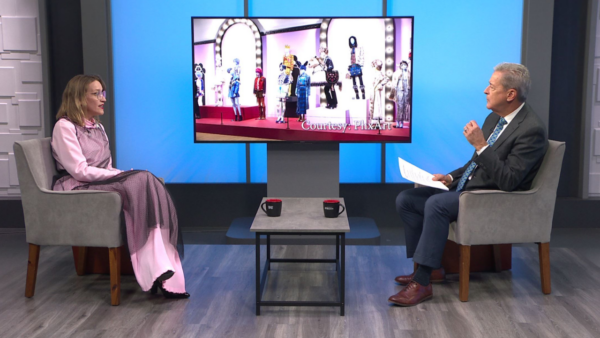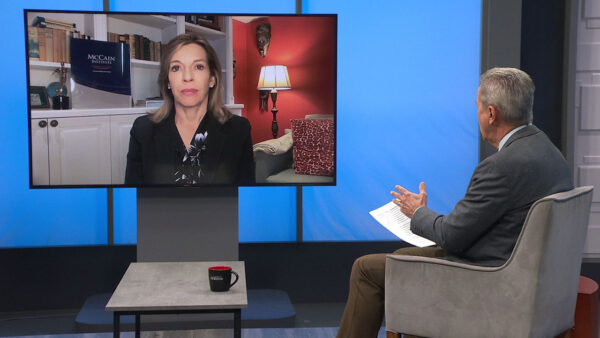Optical Illusions are fun to look at, but they can also give scientists insight into how our eyes and brains function. Researchers Stephen Macknik and Susana Martinez-Conde of Barrow Neurological Institute will explain what they’ve learned about human eyesight and brain function from studying how we see optical illusions.
Ted Simons: our minds may be fooled by strongly held beliefs but you can believe what you see, right? not so fast. researchers from barrows neurological institute in phoenix are looking at optical illusions and how the brain perceive the world. with me is Stephen Macknik and Susannah Martinez-Conde. glad to have you with us. what got you started in the visual illusions?
Susannah Martinez-Conde: we're visual scientists by training. visual illusions are one of the most important tools to understand how our brain constructs our visual experience because they disassociate what is out there from the way we see it. that gives a handling of the mechanisms behind it.
Ted Simons: there's a difference between visual illusions and optical illusions.
Stephen Macknik: that's right. the real world has physical things happening in it like you can have smoke and mirrors, reflections. those are optical illusions. when you have a piece of pencil in a glass of water and it looks like it's bent, that's refraction of light. that's an optical illusion. visual illusions are effects that happen because of the way we process information in our brains. we're not saying the real world isn't out there, it really is, but we've never actually been there, none of us have. and so by studying these illusions, we can really understand better how it is that we interact with each other and the world.
Ted Simons: how much do we know as far as what the brain perceives? what do we know? what do we not know?
Susannah Martinez-Conde: the brain has over 2,000 areas dedicated to processing visual information. we know more or less what the first three stages do. the rest is mostly an open question.
Ted Simons: interesting. we have a bunch of examples here. i want to get to these before we get too deeply in our conversation. the first one is interesting in the sense we have square a and square b and you're telling me that they are both the same shades of gray?
Stephen Macknik: that's right. so if you look at the soda can's shadow, you see that covers the square labeled b and the square labeled a in the background looks dark but they're exactly the same amount of light coming off of there and you can convince yourself of this by putting a mask over this for instance and looking at the two squares.
Ted Simons: why do they look different?
Susannah Martinez-Conde: it depends on context. to the brain, there's no absolute black and white. everything depends on what you compare it with. so for the brain, it doesn't access a and b individually but places them in the context of the shadow cast by the soda can it subtracts the shadow and concludes that b is lighter.
Ted Simons: that plays a part in something as simple as reading? because you've got a white background with black print?
Susannah Martinez-Conde: it does. in fact, if you look at newspaper under artificial light and take the same newspaper outside, in both cases, you see as you mentioned black letters on a white background, however, the amount of photo is reflected by the black letters outside is more than the amount of photos reflected by the white paper inside and yet you see black letters on a white background in both cases.
Ted Simons: interesting. all right, let's get to our next one. this looks a little bit like a rubik's cube but it's different and you're telling me again that these two squares -- now, which are the two that you say are the same color?
Stephen Macknik: so the middle square inside the shadow --
Ted Simons: the bright one there?
Stephen Macknik: that's right. and the middle square on the top surface.
Ted Simons: the dark one?
Stephen Macknik: yes, that's right. those two shades of brown are physically identical on your retina but you see them as different because you're seeing them under different lighting conditions. these illusions, these brightness and these color illusions are incredibly important for us and they allow us to recognize the same object as being the same inside and outside and in different lighting conditions.
Ted Simons: again, why is our brain -- i know mine is why are our brains looking at that going, "those aren't the same colors?"
Susannah Martinez-Conde: it wouldn't be very useful to know the exact color and the exact wave length of each object in the environment whether there's a shadow or direct light because that would mean that the same sweater that you wear inside and outside would change colors when you step in and out of the house. it'll be very confusing to know what fruit is ripe and what isn't so you want a discount environment.
Ted Simons: interesting.
Stephen Macknik: just to follow up on that point. for instance, if you're inside the cave with your child and you walk outside in direct sunlight, physically that child looks very different. different colors of light, different brightnesses of light. it looks physically like a different person but you recognize that as being your child which is a good thing so you don't eat it or something.
Ted Simons: sure.
Stephen Macknik: so you know that's the exact person in these two environments. it's a physical illusion.
Susannah Martinez-Conde: it used to be thought by most people in the field of vision research that illusions are errors of perception. illusions are where the brain gets it wrong but more and more we're seeing that illusions play an active value and in fact these are fundamental processes of our -- that helps us survive.
Ted Simons: there's another one. the deal is if you move your eyes around this, you're saying and i hope it translates on tv as well as it does in print. everything's moving. if you focus on one of the black dots in the middle, everything slows down. why?
Stephen Macknik: well, your motion neurons in your brain, they see when you move your eye around, they're seeing the different shades of gray. we're seeing it in color here but in fact, if you think of them in shades of gray it goes from dark to light to dark to light. and the motion neurons see that as motion in one direction. when they change in the opposite direction, they see it as well in the opposite direction. it's the way we process the motion in individual neurons.
Ted Simons: why am i seeing this when i see that?
Stephen Macknik: not all illusion have an adaptive value per se. But they may come from process in your brain that do so the way that your motion sensitive neurons in your brain are wired up, it just has the side effect of sometimes you'll see motion when there isn't but the fact is that this is -- if you want kind an artificial stimulus with all the repetition of the little bits and pieces that have the different touches of gray all in the same sequence -- so it'll be very rare, almost impossible to see this in nature. so you're not going to get diluted in real life.
Ted Simons: yeah, ok. that's good. that's good to hear. the next is similar in which they show things -- this is the exact same photograph of the leaning tower of pizza. why does the one on the right look like it's angled more than the one on the left?
Stephen Macknik: well, this has to do with the way we see depths in the real world when we see things like two towers, we're standing at the base of them and looking at them, we see two towers that are completely parallel going up into the world, they would converge in the distance or when you're looking at train tracks -- in the next image, you see train tracks. they converge in the distance when they're parallel. what is happening here with two photographs which we haven't evolved to see. they've only existed for the last 150-200 years when you see photographs next to each other, those are two parallel things that don't converse. they are phyiscally parallel though they look like they're receding into the distance. your brain interprets them as it must be diverging.
Ted Simons: is this my brain looking at a do two-dimensional image trying to make sense of it in three dimensional ways?
Susannah Martinez-Conde: that's part of it. it has to do with the mechanisms the brain perceives distance and volume. the fact we can see distance in a painting in a piece of art and how the painters take advantage and develop the rules of perspective, this is because the same mechanisms that makes us see three dimensionality in a flat painting, this is how our brain works.
Ted Simons: this rail road track one is more dramatic than the two towers. you're looking at two photographs that are exactly the same but the one on the left just looks so different.
Stephen Macknik: that's right, it's the same concept. so you see the parallel train tracks in either one of the images converges into the distance whereas if you take the identical photographs of the train tracks, they don't converge into the distance. they're parallel, physically, geometrically. that means to your brain they must be diverging. this is the kind of concept that fred kingdom and elaine georgio at mcgill realized was critically important to how we see depth and was part of our illusion contest we hold every year.
Ted Simons: we've only got a minute left. what kind of response are you getting to this research?
Susannah Martinez-Conde: a good one.
Ted Simons: yeah, i guess.
Susannah Martinez-Conde: visual illusions -- they're fun to study because they're not only fundemental in studying vision but they're also important in understanding vision disease. that's part of what we try to do in the barrow neurological institute to apply the basic discoveries we do in our laboratories to translate them to the clinic.
Ted Simons: and again the response in what you're learning from this kind research?
Stephen Macknik: it's been tremendous. one of our articles on this stuff, our on-line articles is scientific american, we have a monthly column, was the most downloaded article in scientific american history. In response they published 169 issues currently on the newsstands.
Ted Simons: there are things in this issue that will almost give you a headache looking at these things because they're remarkable. it's fascinating stuff. thank you both for joining tonight. we appreciate it.
Susannah Martinez-Conde: thank you for having us.
Stephen Macknik:Barrow Neurological Institute;Susana Martinez-Conde:Barrow Neurological Institute;























